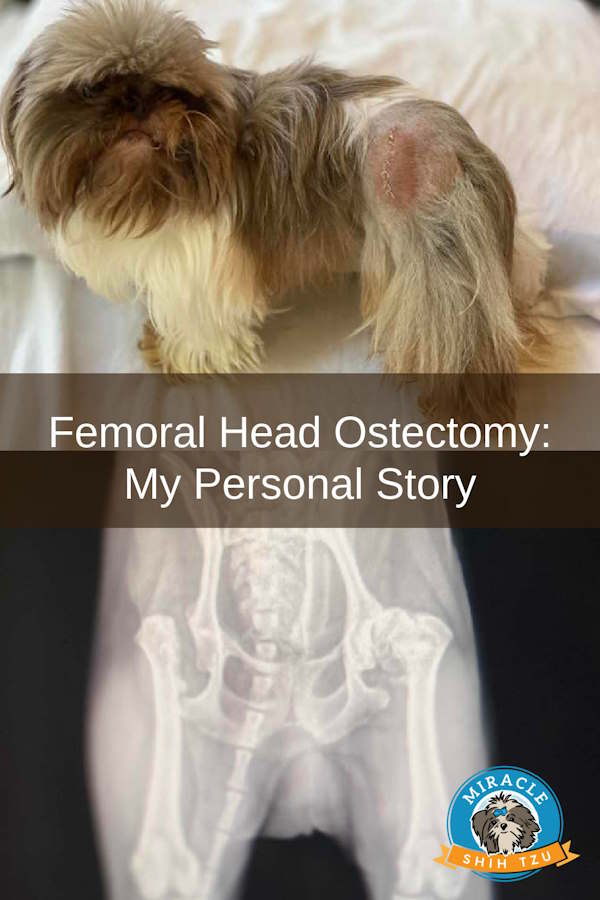Femoral Head Ostectomy Surgery in Small Dogs: Personal Story
Femoral Head Ostectomy Surgery in Small Dogs, by Janice Jones M.A. |Published 11-06-2023
As a Shih Tzu dog owner, you want the best for your furry friend, especially regarding their health and well-being. Unfortunately, dogs can experience various orthopedic conditions that may require surgery to alleviate pain and improve their quality of life. One such procedure is FHO surgery, which stands for Femoral Head Ostectomy.
In this article, we will explore what FHO surgery entails, when it is recommended for dogs, its benefits, the risks and complications involved, and most importantly, my personal experience dealing with my tiny Shih Tzu dog, Ketchikan, whom you may have met if you’ve ever been to my home.
 This is Ketchikan, my 5-pound Shih Tzu dog, once a stud dog but now a devoted and loved family pet. At 8, he is showing no signs of slowing down. He loves to play with people and his canine brothers and sisters.
This is Ketchikan, my 5-pound Shih Tzu dog, once a stud dog but now a devoted and loved family pet. At 8, he is showing no signs of slowing down. He loves to play with people and his canine brothers and sisters.My Experience with FHO Surgery
This is the story of my tiny Shih Tzu dog, Ketchikan, who had not one but two femoral head osteotomies performed to alleviate pain and improve his life. In case you are curious, Ketchikan was named for a small town in Alaska. Many years ago, we visited this small town on a day when the residents had not seen the sun for the entire season.
It was sunny, and one resident thanked me for bringing the sun. Even though I couldn’t take credit for that, I always remember that day. After that, I always felt that Ketchikan brought the sun into my life. He was a tiny dog, often called a Shih Tzu Imperial. He was born in southeast Ohio to a breeder known for whelping tiny Shih Tzu dogs.
Here’s a Quick Anatomy Lesson for Anyone Interested
Feel free to skip this section, but for anyone interested, the hip of the dog is very similar to human anatomy. Both your dog and you can suffer from degeneration of the hip joint.
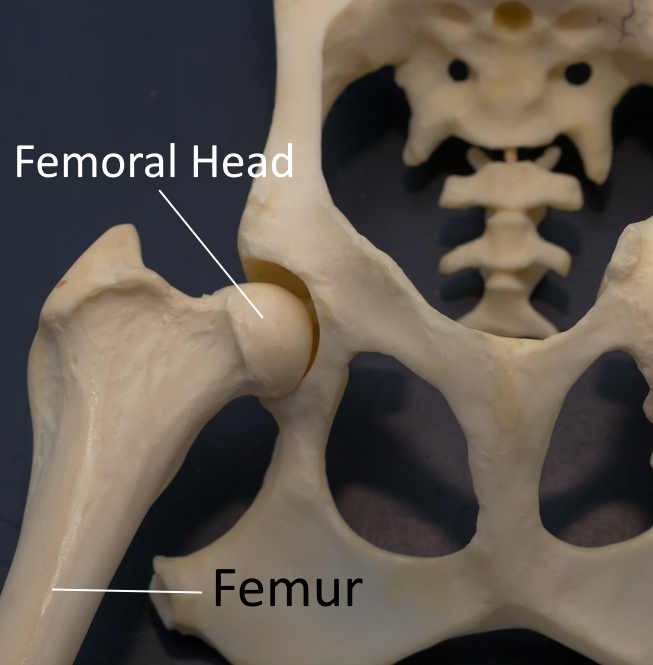 This is a model of a dog pelvis where the femoral head fits nicely within the socket formed by the canine pelvis.
This is a model of a dog pelvis where the femoral head fits nicely within the socket formed by the canine pelvis.What is FHO Surgery?
FHO surgery is performed on dogs to remove the femoral head, the ball-shaped end of the thigh bone that connects to the hip joint. This procedure is typically recommended in cases where the hip joint is severely damaged or diseased, causing pain and limiting mobility. By removing the femoral head, the joint is essentially converted into a false joint, allowing the surrounding muscles to support and stabilize the leg.
In Ketchikan’s case, his hip joint was damaged, most likely due to genetics. Ketchikan underwent not one but two femoral head ostectomy procedures, both performed by Dr. Glenn Thorston, DVM of the Boston Heights Veterinary Hospital.
When is FHO Surgery Recommended for Dogs?
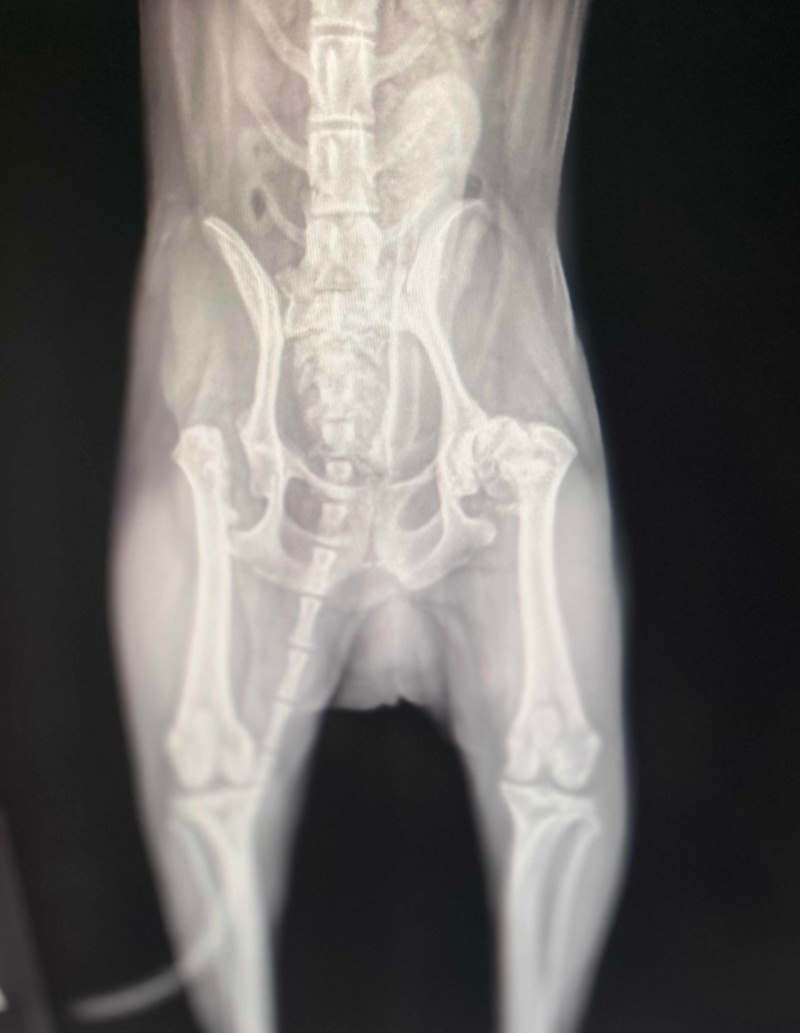 This is Ketchikan's X-ray before his second Femoral Head Ostectomy. He underwent surgery on his right side about 4 years ago and is getting ready for surgery on his left side.
This is Ketchikan's X-ray before his second Femoral Head Ostectomy. He underwent surgery on his right side about 4 years ago and is getting ready for surgery on his left side.FHO surgery is commonly recommended for dogs suffering from hip dysplasia, Legg-Calve-Perthes disease, or traumatic hip injuries. These conditions can result in chronic pain, lameness, and reduced mobility. Your veterinarian will assess your dog's condition and determine if FHO surgery is the most suitable treatment option. Age, size, and overall dog health will also be considered.
Benefits of FHO Surgery for Dogs
FHO surgery offers several benefits for dogs with hip joint issues. Firstly, it relieves pain by eliminating the damaged femoral head, often the source of discomfort. This can significantly improve your dog's quality of life, allowing them to move more comfortably and engage in regular activities.
Additionally, FHO surgery can enhance joint stability and prevent further degeneration, ultimately increasing your dog's mobility and longevity.
Why not a Total Hip Replacement?
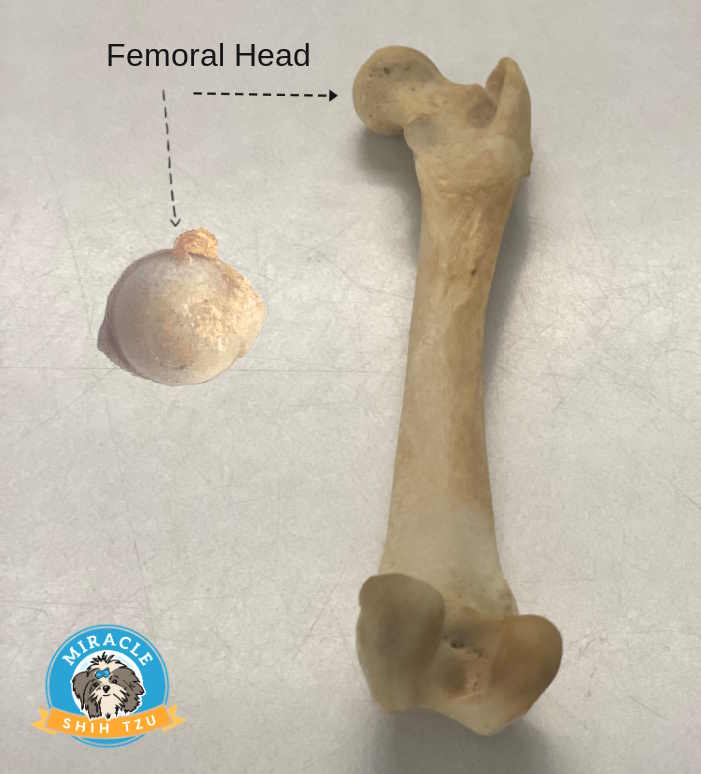 This is an actual canine femur and the head of the femur, both obtained during surgery from two different dogs.
This is an actual canine femur and the head of the femur, both obtained during surgery from two different dogs.The femoral head ostectomy may sound a bit drastic. Still, it's a fantastic option for pets with hip dysplasia or other conditions that cause pain and discomfort. By removing the femoral head, the friction and pressure in the hip joint are reduced, leading to improved mobility and decreased pain.
This procedure is less invasive than a total hip replacement and has a shorter recovery time, making it an excellent choice for those who want to get back on their feet quickly.
On the other hand, we have total hip replacement, a procedure that replaces the entire hip joint with artificial components. The damaged joint is replaced with metal, ceramic, or plastic prosthetic components, providing a smooth and functional hip joint.
According to Dr. Thorson, the femoral head ostectomy is a poor man’s alternative to a total hip replacement - the perfect solution for the average pet owner who wants the best for their dog but doesn’t have the funds for a more expensive procedure.
Risks and Complications of FHO Surgery
While FHO surgery is generally safe and effective, it is essential to be aware of the potential risks and complications. Like any surgical procedure, there is a risk of infection, bleeding, or adverse reactions to anesthesia. For brachycephalic dog breeds like the Shih Tzu, anesthesia is always a concern even in young dogs.
Additionally, some dogs may experience a limited range of motion or muscle weakness post-surgery. However, proper post-operative care and rehabilitation can often minimize or overcome these complications.
FHO Surgery Cost and Considerations
The cost of FHO surgery for dogs can vary depending on factors such as the geographical location, the size of your dog, and the extent of the procedure. On average, FHO surgery can range from $1,000 to $3,500. It is crucial to discuss the cost and financial considerations with your veterinarian beforehand, as well as explore any available pet insurance options.
Remember, the surgery cost should not be the sole determining factor; the well-being of your dog should always take precedence.
Preparing Your Dog for FHO Surgery
Before FHO surgery, your veterinarian will provide specific instructions on how to prepare your dog.
In Ketchikan’s case, we were told to withhold food the night before, but water was permitted until surgery. It is crucial to follow these instructions meticulously to ensure a successful procedure.
Moreover, creating a calm and comfortable environment for your dog is as important as offering them emotional support.
The FHO Surgery Procedure
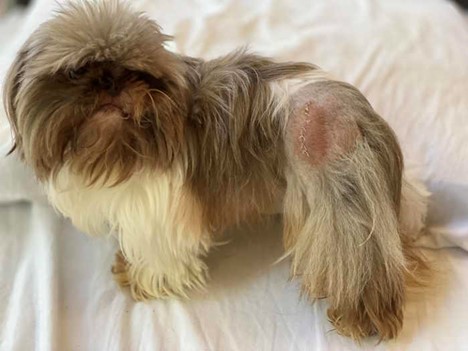 Ketchikan after surgery. This was taken 24 hours after surgery. You will see slight swelling and redness at the incision site. Otherwise, he did fine.
Ketchikan after surgery. This was taken 24 hours after surgery. You will see slight swelling and redness at the incision site. Otherwise, he did fine.During FHO surgery, your dog will be placed under general anesthesia to ensure they remain pain-free and immobile throughout the procedure. Your vet will make an incision near the hip joint, carefully remove the femoral head, and reshape the socket to create a false joint.
In Ketchikan’s case, the head of his femur had degenerated to the point where a clean incision was impossible, and the femoral head was removed in pieces.
Once the procedure is complete, the incision will be closed with sutures or staples. The duration of the surgery can vary depending on the case's complexity, but it typically lasts between one to two hours. You will likely need to make a post-op appointment for suture removal.
Post-operative Care and Rehabilitation for Dogs after FHO Surgery
After FHO surgery, your dog will require attentive post-operative care in the vet hospital supervised by the veterinary technician. You will likely be given instructions on pain management, wound care, and physical therapy exercises if necessary. It is crucial to follow these instructions diligently to promote healing and optimize your dog's rehabilitation. Rehabilitation may involve gentle exercises, controlled walks, and possible hydrotherapy to improve muscle strength and joint flexibility.
Success Stories: How FHO Surgery Has Improved Dogs' Quality of Life
Ketchikan, my 5-pound Shih Tzu Dog, experienced remarkable improvements in their quality of life following his FHO surgery. When I picked him up the next day, he ran from the kennel to me, waiting in the front office as if nothing had happened.
It was impossible to tell if he was in pain as his renewed zest for life was immediately apparent. His seven other Shih Tzu brothers and sisters were so pleased to see him home, safe and sound. He once required a free lift when climbing steps, but after surgery, he seems to live his life to the fullest. He still wants all the hugs and cuddles he can get, but the life-changing procedure means he no longer needs me to carry him from place to place.
Frequently Asked Questions about FHO Surgery for Dogs
Q: What is the recovery time after FHO surgery? A: The recovery time can vary depending on the individual dog and the extent of the surgery. Generally, it takes around eight to twelve weeks for dogs to recover and regain their mobility fully. In Ketchikan’s case, he looked like a new dog in less than 24 hours.
Q: Will my dog require long-term medication after FHO surgery? A: While some dogs may require pain medication or anti-inflammatory drugs during recovery, long-term medication is not always necessary. Your veterinarian will guide you on the appropriate medication regimen for your dog's needs.
Q: Can my dog lead an everyday life after FHO surgery? A: Yes, dogs can lead a normal and active life following FHO surgery with proper post-operative care and rehabilitation. They may require some adjustments in their exercise routine, but they can still enjoy walks, playtime, and other activities.
Conclusion: Is FHO Surgery the Right Option for Your Dog?
FHO surgery has proven to be an effective treatment option for dogs with hip joint issues, offering pain relief and improved mobility. However, it is crucial to consult your veterinarian to determine if it is the right option for your dog.
Consider your dog's specific condition, age, overall health, and the potential risks and benefits associated with the surgery should be considered. With proper care and rehabilitation, FHO surgery can significantly enhance your dog's quality of life and allow them to enjoy many happy and active years by your side.
If your dog may benefit from FHO surgery, consult your veterinarian to discuss the best action. Your vet will be able to assess your dog's condition and provide personalized guidance tailored to their needs. Remember, your dog's well-being is of utmost importance, and together with your veterinarian, you can make informed decisions to improve their quality of life.
My Ketchikan has been a beloved pet for the past eight years. He has sired several litters before my veterinarian, Dr. Glenn Thorston, recommended that he be removed from the gene pool. He has since been a devoted, if not tiny, pet. He was featured in a video created by Paul Buckingham from SBI Australia.

Femoral Head Ostectomy in Small Dogs: Pin for Future Reference
"Hi, I'm Janice Jones, a former veterinary technician and Shih Tzu expert with over 40 years of experience with the breed. Through Miracle Shih Tzu, I combine my medical background and extensive breed knowledge to provide reliable, practical advice for Shih Tzu owners. My mission is to help you give your Shih Tzu the happiest, healthiest life possible through evidence-based information and real-world solutions. Whether you're new to the breed or a seasoned owner, you'll find trusted guidance here for all aspects of Shih Tzu care.
I hold an undergraduate degree in Psychology with a minor in biology, Early Childhood Education, and Nursing, and a Master's in Mental Health Counseling.
